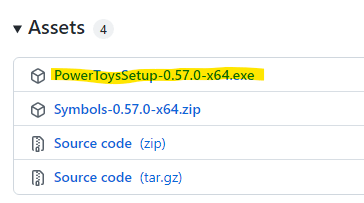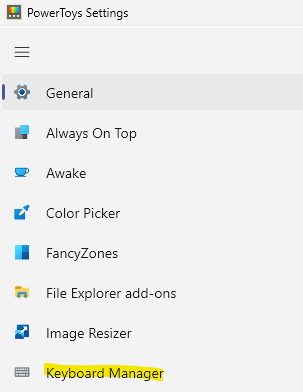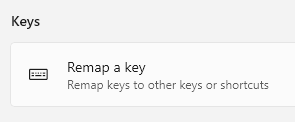There can be many scenarios when you would want to disable a key on your keyboard on your Windows 10/11 PC. For instance, the key may be stuck and is unusable, you just don’t need the key anymore, or you simply cannot handle the key. Because of this, you end up hitting the wrong key every time and this can be frustrating.
While working on your PC, hitting the wrong key all the time ends up wasting a lot of your productive time and hence, it’s better to disable the problem key to be able to continue with your work as usual, without pressing the wrong key every time.
In this post, today, we will show you how to disable the problem key on your keyboard on your Windows 10/11 PC.
Download and Use Microsoft PowerToys
Since the launch of Windows 10, Microsoft introduced a system utility package known as Microsoft Power Toys. This utility is known to assist users with different aspects while working on Windows and one of them is the Keyboard Manager. Let’s see how to access the Keyboard Manager through the PowerToys application:
Step 1: Click on the below link to download PowerToys:
Step 2: Scroll down till you see the Powertoys setup exe file.
Step 3: Click on .exe file to download and install Power Toys

Step 5: Once the .exe file is downloaded, click to open the file.
Step 6: You will now see the PowerToys Setup window.
Click Next to proceed.
Step 7: Now, follow the on-screen instructions to complete the installation.
Step 8: Once installed, open the PowerToys utility and it will open the window named – PowerToys Settings.
Here, click on the Keyboard Manager option on the left.

Step 9: Next, go to the right side and under the keys section, click on Remap a key.

Step 10: Now, in the Remap keys window, click on the “+” symbol under Key.
Step 11: You can either type the key name (letter/symbol/number) in the Type field or select it from the drop-down.

Next, under the Mapped to field, Type or select Disable from the drop-down.
Once done, press OK to save the changes.

Exit the PowerToys Settings window and the problem key should be disabled now.
*Note – In the similar manner, you can also disable a shortcut key. Simply follow the Step 8 and then select Remap a shortcut from the right side, and then follow the Steps 10 and 11 to disable the desired shortcut key.
To restore the key in future, repeat the Steps 8 through 10, and hit the bin icon to delete the key remapping.
Download and Use the KeyTweak App
If you are looking for a free tool that allows you to disable a specific key on your keyboard, then KeyTweak is the first choice for many. Once downloaded, you can pick the problem key from the tool and disable it. Let’s see how;
Step 1: Open your browser and run a Google search for KeyTweak.
Step 2: In the results, click on any trusted website to download the KeyTweak app.
For instance, I clicked on the 1st result.
Step 3: Click on the Download button to proceed with the download.
Step 4: Once downloaded, navigate to the Download folder and click on the setup file to begin the installation.
Step 5: In the window that opens, click on I Agree to agree with the terms and conditions and proceed.
Now, follow the on-screen instructions to finish the installation.
Step 6: Now, go to Start and type keytweak in the Windows search bar.
Under the Best match field, click on KeyTweak app to open the program.
Step 7: Now, in the KeyTweak app, the keys are numbered and hence, place the cursor on each key to find the key you want to disable.
For example, I want to disable the Q key here and hence, I clicked on number – 17 on the keyboard.
Step 8: As you select the number, it shows which key you selected at the bottom, under the Keyboard Controls.
Here, you can see the Key Selected and to which letter or symbol it’s mapped to.
Now, press the Disable Key button and the selected key is disabled.
You can now continue to use the PC keyboard with the problem key disabled and hence, even if you accidentally hit it while typing, it won’t type anything.
*Note – If at any time later, you want to enable the key back again, simply open the KeyTweak app and click on the Restore Default button below to restore the key.
Download and Use AutoHotkey
AutoHotkey is another free and open source utility that allows you to automate tasks that you need to do frequently, for instance, one of them is remapping or disabling keys. However, it allows you to automate only certain keys like the numbers, symbols or general keys (CapsLock, Enter, Tab, etc.) or the Cursor Control Keys (Delete, PgUp, PgDn, Insert, etc.), Letters and more.
You can check the list of eligible keys that can be disabled on their official page here.
Now, follow the below process to disable the problem key using the AutoHotkey utility:
Step 1: Click on the below link to visit the AutoHotkey official page to download the utility:
Step 2: Now, in my case, I want to disable the Shift key on my keyboard. So, I check the AutoHotkey list for the keys and then proceed to disable the key by following the below process:
To disable a key, open Notepad (or, any text document) and type the key name followed by ::return.
For example, in my case, I typed:
LShift::return
Step 3: Now, go to the File tab and select Save As.
Step 4: In the Save As window, name the file as per your convenience followed by .ahk as the file extension.
Click on Save to save the changes.
Step 5: Now, go to the location where you have saved the AutoHotkey file.
Double-click on it to run the file and as soon as it is run, it will disable the problem key.
You can now continue to use your keyboard without the fear of using the wrong key.
*Note – If you want to restore the key in future, simply go to the system tray on your Taskbar, right-click on the H key and select Suspend Hotkeys.